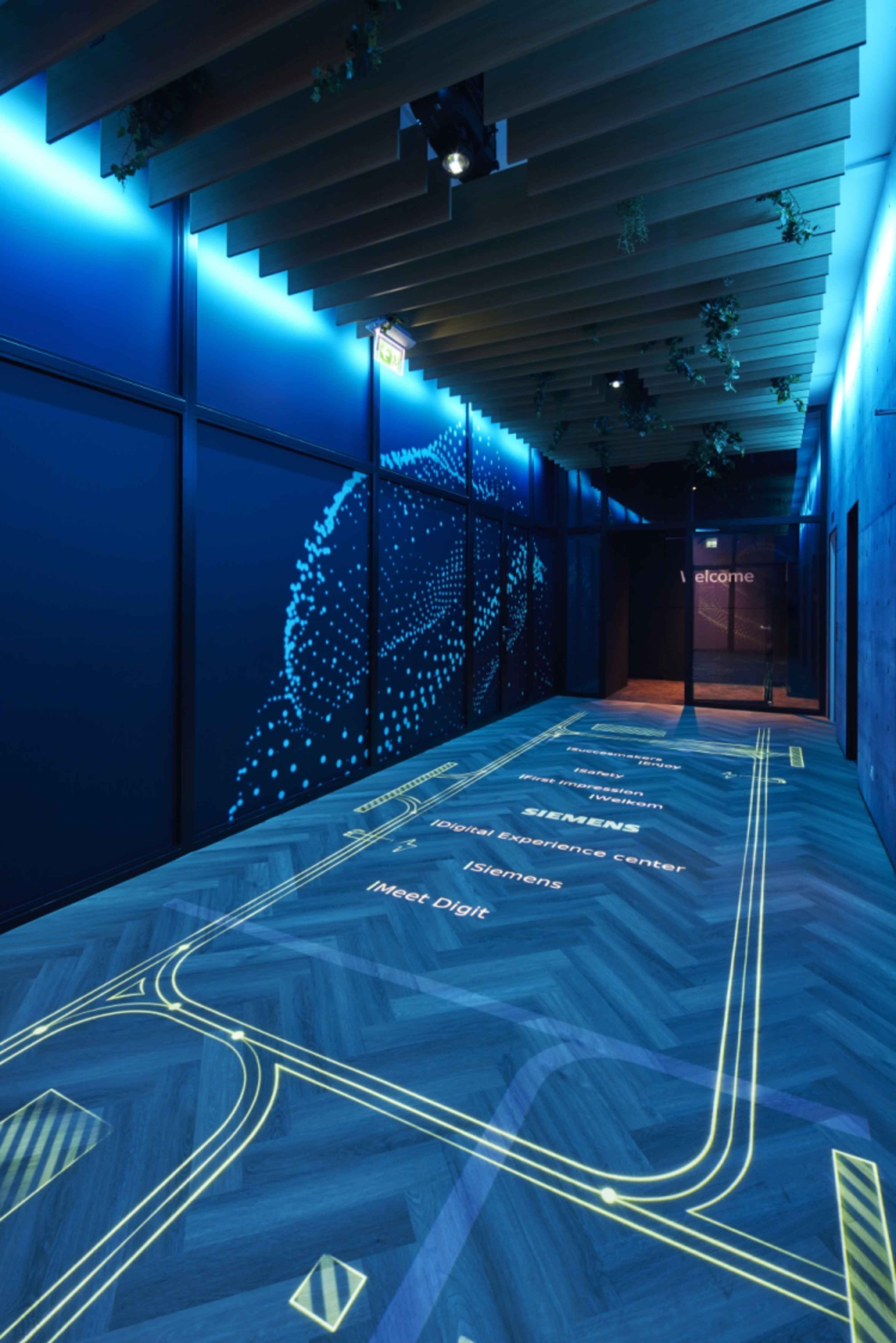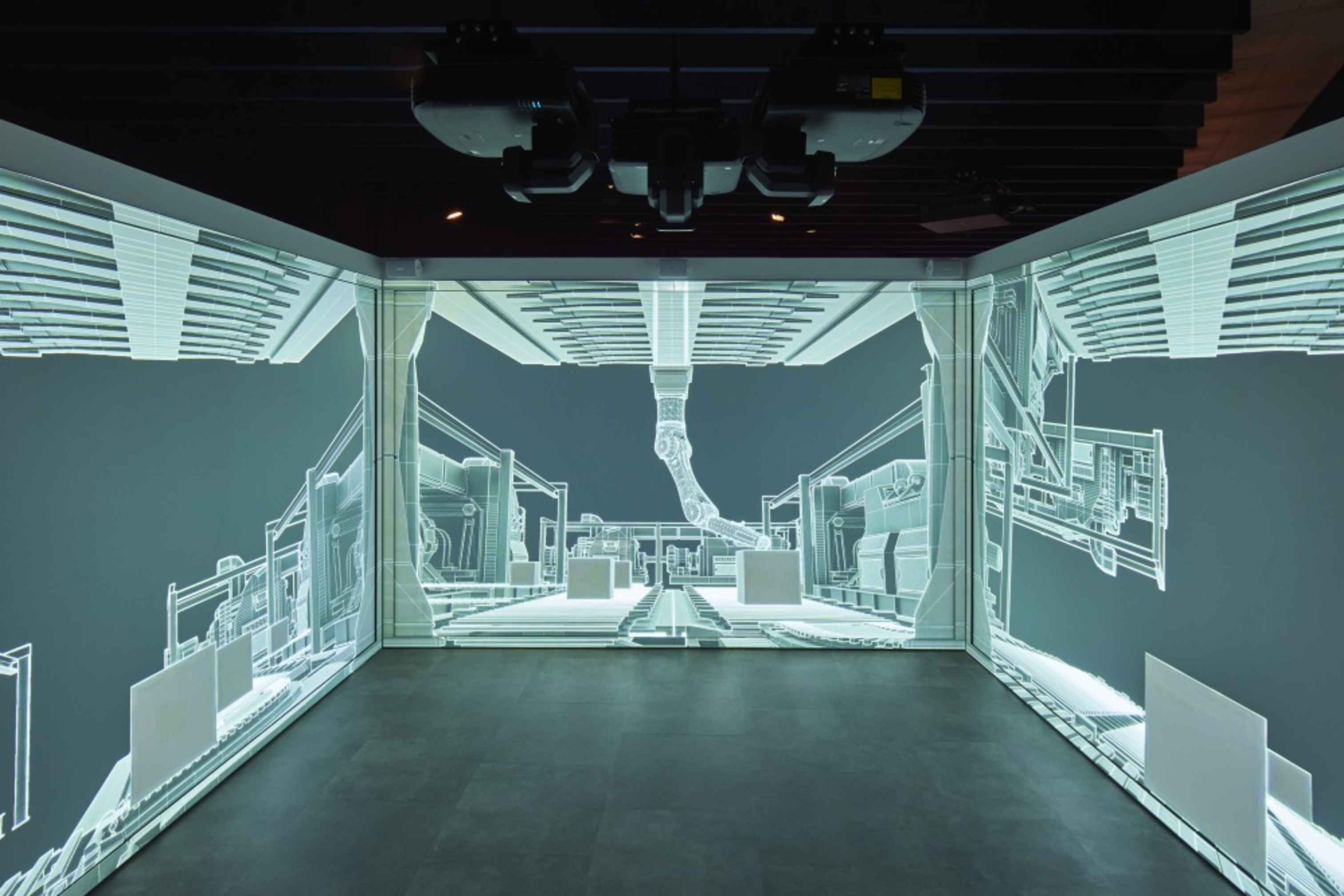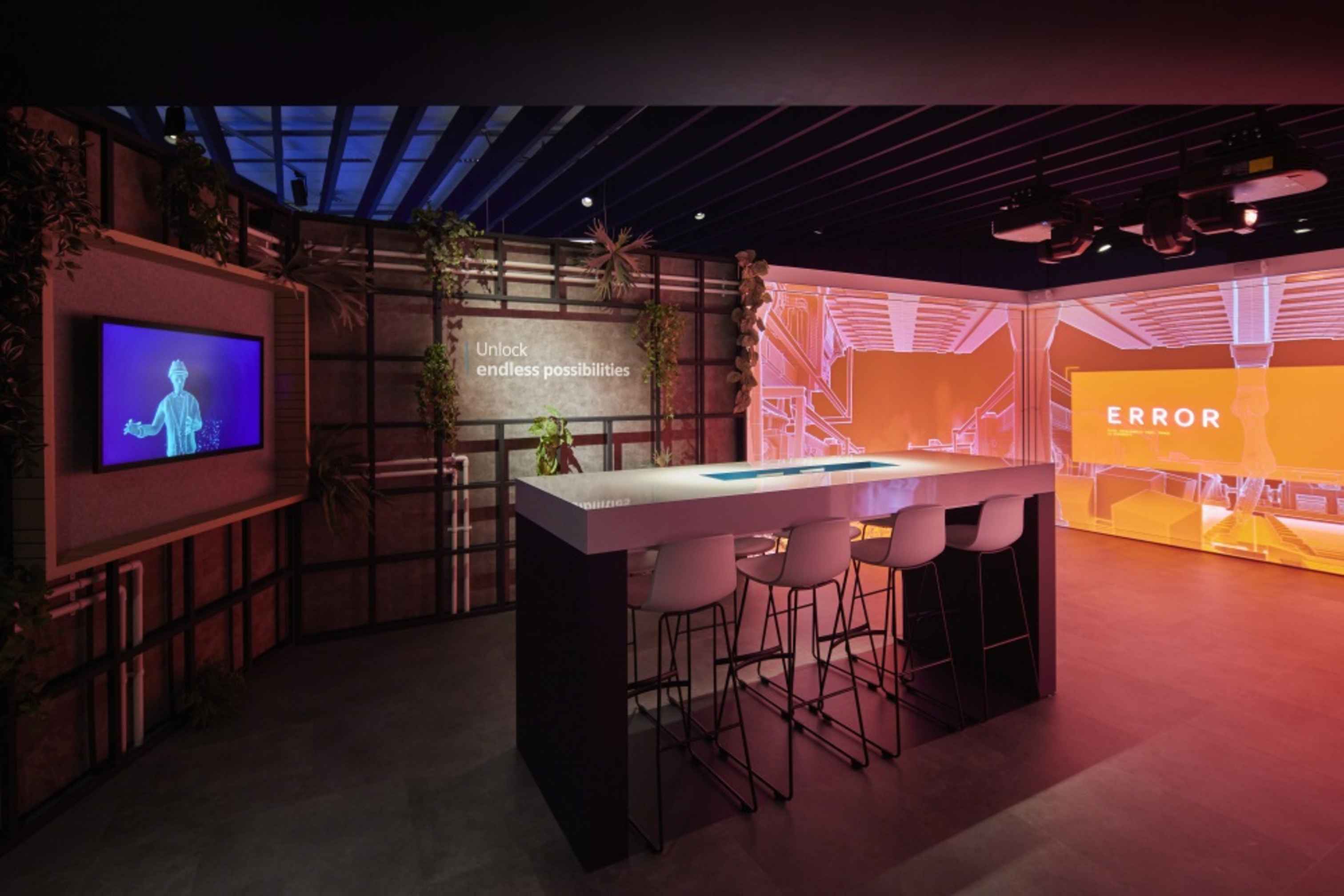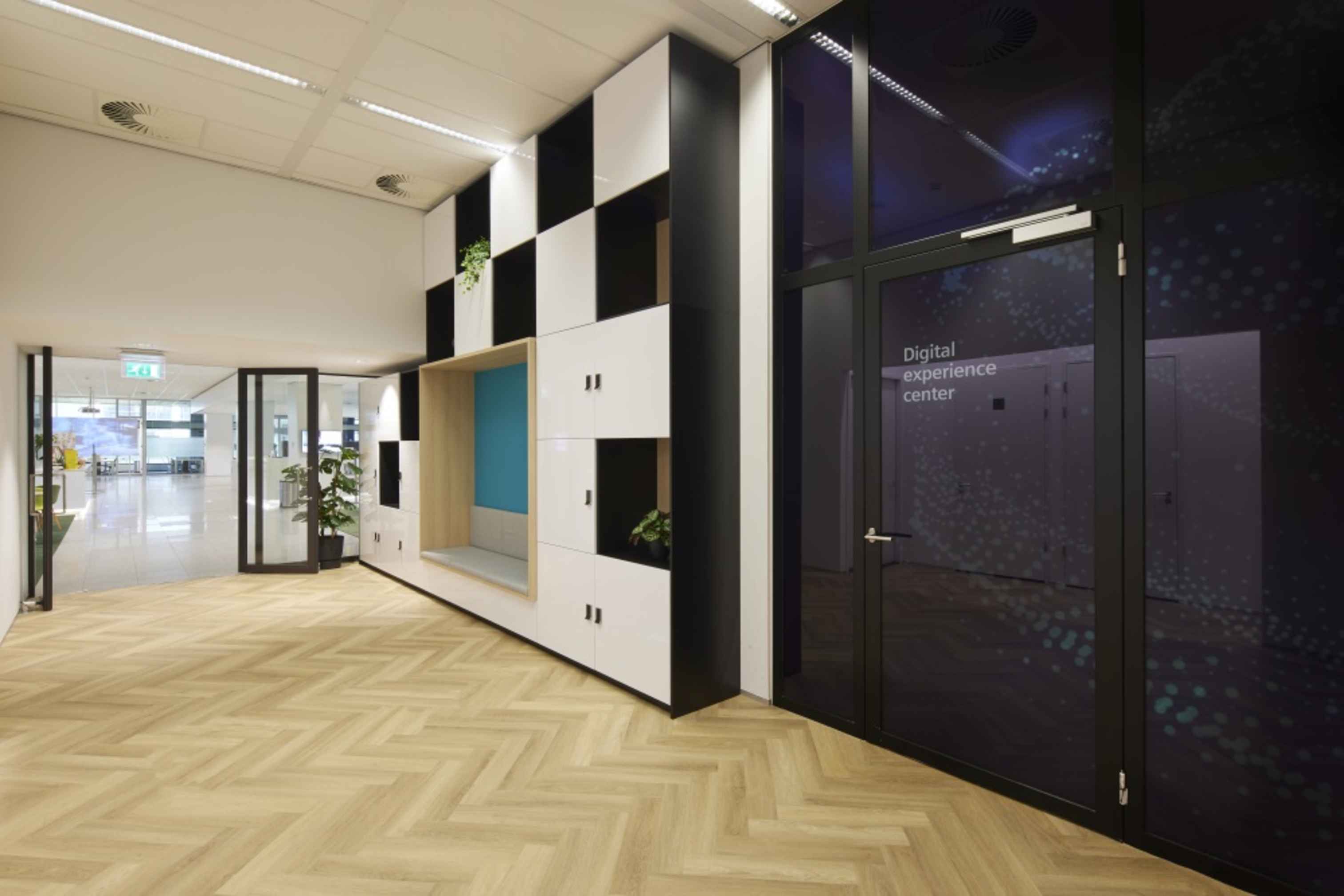One of the giants of the technology world wanted a new immersive experience centre in its Dutch HQ to explore the importance of digital transformation. Paul Milligan reports on the impressive final product.
When asked how this project came to system integrator First Impression, the answer from its CTO Hadewig Both, is as honest as it is surprising; “They went on Google, typed in AV experience centre, and they found us.” What the answer doesn’t tell you is that First Impression came high up on that particular Google search because the company has a long history of providing such spaces, in what is a very specialised skill within the AV world.

Technology giant Siemens wanted to build an immersive experience centre in its HQ in The Hague, the Netherlands, to tell a story around the concept of Industry 4.0 and the digital twin. A digital twin is a virtual doppelganger of a product, machine, process, or entire production facility, containing all data and simulation models relevant to the original. For those unfamiliar with the concept of Industry 4.0, it involves a mix of hardware, software, service and expertise. Once First Impression was given the contract its first job was to design the Siemens Digital Experience Center (DEX) so it could tell the story of the future of Industry 4.0. With no consultant involved, First Impression was in contact with the client from day one, in a process that took ten months in total, with six months spent on the conception and design, two months spent in preparation, and another two months spent on installation on-site.
The brief to First Impression was for “An experience centre where they can really show the customers what their products can do for them, in an interactive way. They wanted it to look nice, and they wanted some cool features,” says Both. The result
is a fantastic fusion of AV technologies, including edge-blended projection, interactivity and holograms, all merged into a 200 sq m space that takes visitors on a journey but also allows them to find out information individually too.

After the guide has welcomed the customer to the DEX, they enter the entrance hall where the content of the floor projection can be personalised for each client i.e a projection of their own logo. Projection is supplied by two Epson 9,000 lumen edge-blended projectors, with signal distribution handled by Extron through HDBaseT, and the content is managed by a Scala media player. The content projected differs per vertical market in which the visiting client is related to. These markets include food and beverage, water and wastewater and tank terminals. This distinction is visible in all content throughout the DEX, from floor projection at the entry to the displayed presentation in the theatre space.
The next step in the tour is the theatre where the guide opens the doors and starts the general (or if desired, the industry specific) video tailored to the customer. This is again shown via Epson projectors, Extron signal distribution and Scala media players. In addition, audio is provided by Bose 5.1 loudspeakers and room control is handled via an Extron 5-in touchpanel. The video discusses global trends in digital transformation, at the end of the video the lights go on and the group walks to the next point in the tour, where a big surprise awaits.

Here, the guide conveys a story, addressing the need for digital transformation to keep up with societal and economic changes. By creating a ‘Digital Twin’ of the entire chain, a company can gain a much better insight into business performance. At this point in the DEX, the guide activates the hologram guide named ‘Digit’, by pressing a hidden button in the floor. The hologram is brought to life via a Panasonic 8,000 lumens projector shining on a Glimm Hologram foil on anti-reflective glass. Four theatre spotlights are used for backlighting, and a Samsung 43-in touchscreen is also in the room to play a supporting role to the storyline.
The ‘Digital Twin’ or virtual version of the tour guide will make its appearance in different spots in the DEX, using different AV methods to create a continual wow factor. As the group moves on to the next set-up, they encounter the digital guide Digit again on another display, but it’s not in hologram form, this time it appears on a 3x2 Absen LED wall to explain how the customer can validate the performance of new products using the digital twin. When the story of both - the ‘real’ and the digital guide - is ready, the guests are invited around a touch table. The interactive story is continued via the touch table, consisting of an Elo 46-in display incorporated into the table, with content running on the Intuiface interactive platform.

In the next multifunctional room, the customer sees three interactive projection walls that initially show a machine running at full speed. The sound gets louder and louder, followed by a loud bang. A frozen virtual machine appears on the large centre projector screen and alarms appear on the other two projector screens. After a few seconds, the image goes black with just a pulsating emergency button on a tablet that is mounted on a wall bracket. This button must be pressed to activate the hologram of Digit again. The virtual guide explains what happened and how a digital twin could have prevented this from happening. The projection is supplied by three Epson 9,000 lumens projectors. The interactive wall covers 27 sq m and features three IR touch frames on the wall to support interactivity. Again HDBaseT signal distribution is via Extron and 5.1 audio is from Bose, the content is run via a combination of Scala and Multitaction.
In the next room visitors see a mixing and production machine to give an impression of what the machine performance looks like in an operational environment. The guide’s story for this part is supported by light and audio effects and the virtual guide adds an explanation via a wall display. A cup of coffee is then enjoyed by the virtual barista and the group then continues the tour to the last point: back to the multifunctional room where the group can work on the customer’s concrete plans. The three projector screens now work with a touch function, with sensors incorporated in the edge of each panel, IR technology here comes from PQlabs.

The way the space is divided makes the entire experience centre multifunctional. The room was divided into areas and the areas were then divided into sections. The next step was to create physical touch points that contribute towards putting the client centre stage in the room. The challenge was to prevent too early a reveal of the future steps in the story, to do this First Impression and experience marketing agency Succesmakers made use of partitions and has the possibility to switch certain content elements on or off. In some of the areas, triggers were installed to automatically start the next touch point. This gives the visitor the idea of entering a new space.
At the end of the tour, the visitors come back in the centre area to work on their project or have a meeting with a Siemens consultant. At that moment, the interactive projection walls can be used to brainstorm, work and plan. As all three walls are provided with IR technology, the walls are fully touch enabled.
The most difficult part of the project for First Impression was building a hologram in such a small space because the optical illusion becomes more difficult says Hadewig Both. “We had to do a lot of testing on where to put the projector, which glass we needed, what are we going to do with the shape that comes through the holographic glass, all in a very compact room, so that was quite challenging.” Another significant challenge for Both was the sheer variety of AV technologies employed. “It’s lighting, it’s audio, it’s video, it’s digital signage, it’s interactive systems, its sensors, RFID, and then the whole combination of those is always challenging.” Getting the show to run correctly and in the right order also presented technical problems for First Impression. Both explains how it works; “There are triggers for the whole journey, sometimes it’s just a foot controller, sometimes it’s time based (ie three minutes after the end of the video), sometimes it’s an IR sensor. To make it all work together was quite a challenge.” The shows are set up via a calendar tool within Siemens, which holds all of the details of the forthcoming meetings and client visits planned. “That information sets the whole experience centre to a certain level of the content. If you are from vertical one, vertical two or industry one or industry two, you get pre-aligned content all from the meeting scheduling tool,” explains Both.

The majority of product testing was done off-site, with everything built and tested at First Impression’s offices, apart from the hologram which was too difficult to replicate in another environment because the space it lives within DEX is so small and unique.
Going forward First Impression has a service contract for DEX as Both outlines; “A lot of the AV systems are in our dashboarding systems so we can have a look at the status of the hardware online to see if it’s patched correctly. We have a whole system of making sure that the right patches are on and firmware is right for every hardware device.”
Final word on this fantastic project goes to Both; “The power of experience lies in the interaction, so rather than just transmitting information, you should look to connect with the customer. First Impression really believes in storytelling on such a high level. That is why we approached a complex project like this from the concept and not initially from the hardware. Hardware is very important and provides the ultimate wow effect but concepting has been key in this project."
KIT LIST
Audio
Bose 5.1 loudspeakers, audio processors, power share amplifiers
Extron 5.1 surround processors
Video
Absen 2.9mm LED tiles
AOpen media players
Barco Clickshare
Ecler signal distribution
Elo 46-in displays
Epson 9,000 lumens projectors
Extron HDBaseT signal distribution, 10-in and 5-in control panels, DTP2 switcher/extenders
Glimm Hologram foil
Intuiface platform
LG 55-in OLED display
Multitaction software
Panasonic 8,000 lumen projectors
Samsung 85-in displays, 43-in touch screens
Scala media players